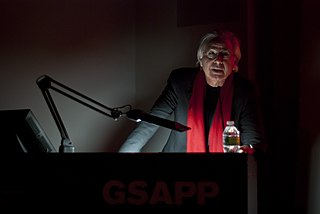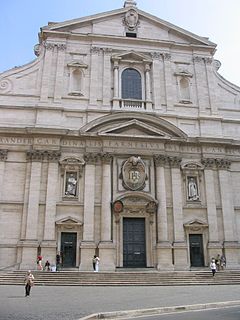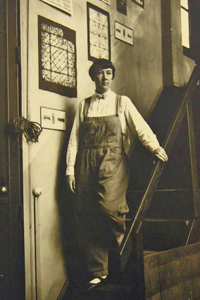
Eugène Emmanuel Viollet-le-Duc was a French architect and author who restored many prominent medieval landmarks in France, including those which had been damaged or abandoned during the French Revolution. His major restoration projects included Notre-Dame de Paris, the Basilica of Saint Denis, Mont Saint-Michel, Sainte-Chapelle, and the medieval walls of the city of Carcassonne, and he planned much of the physical construction of the Statue of Liberty. His later writings on the relationship between form and function in architecture had a notable influence on a new generation of architects, including Victor Horta, Hector Guimard, Antoni Gaudí, Hendrik Petrus Berlage, Louis Sullivan and Frank Lloyd Wright.

Charles-Édouard Jeanneret, known as Le Corbusier, was a Swiss-French architect, designer, painter, urban planner, writer, and one of the pioneers of what is now regarded as modern architecture. He was born in Switzerland and became a French citizen in 1930. His career spanned five decades, and he designed buildings in Europe, Japan, India, and North and South America.

The Capitolium or Capitoline Hill, between the Forum and the Campus Martius, is one of the Seven Hills of Rome.

Bernard Tschumi is an architect, writer, and educator, commonly associated with deconstructivism. Son of the well-known Swiss architect Jean Tschumi and a French mother, Tschumi is a dual French-Swiss national who works and lives in New York City and Paris. He studied in Paris and at ETH in Zurich, where he received his degree in architecture in 1969.

Mathematics and architecture are related, since, as with other arts, architects use mathematics for several reasons. Apart from the mathematics needed when engineering buildings, architects use geometry: to define the spatial form of a building; from the Pythagoreans of the sixth century BC onwards, to create forms considered harmonious, and thus to lay out buildings and their surroundings according to mathematical, aesthetic and sometimes religious principles; to decorate buildings with mathematical objects such as tessellations; and to meet environmental goals, such as to minimise wind speeds around the bases of tall buildings.

Modern architecture, or modernist architecture, was an architectural movement or architectural style based upon new and innovative technologies of construction, particularly the use of glass, steel, and reinforced concrete; the idea that form should follow function (functionalism); an embrace of minimalism; and a rejection of ornament. It emerged in the first half of the 20th century and became dominant after World War II until the 1980s, when it was gradually replaced as the principal style for institutional and corporate buildings by postmodern architecture.

Auguste Perret was a French architect and a pioneer of the architectural use of reinforced concrete. His major works include the Théâtre des Champs-Élysées, the first Art Deco building in Paris; the Church of Notre-Dame du Raincy (1922–23); the Mobilier National in Paris (1937); and the French Economic, Social and Environmental Council building in Paris (1937–39). After World War II he designed a group of buildings in the centre of the port city of Le Havre, including St. Joseph's Church, Le Havre, to replace buildings destroyed by bombing during World War II. His reconstruction of the city is now a World Heritage Site for its exceptional urban planning and architecture.

The Unité d'habitation is a modernist residential housing design principle developed by Le Corbusier, with the collaboration of painter-architect Nadir Afonso. The concept formed the basis of several housing developments designed by him throughout Europe with this name. The most famous of these developments is located in the southern part of Marseille. It was inscribed on the UNESCO World Heritage List in 2016 along with 16 other works by Le Corbusier, because of their importance to the development of modernist architecture.
This is a timeline of architecture, indexing the individual year in architecture pages. Notable events in architecture and related disciplines including structural engineering, landscape architecture, and city planning. One significant architectural achievement is listed for each year.

Amédée Ozenfant was a French cubist painter and writer. Together with Charles-Edouard Jeanneret he founded the Purist movement.

Notre-Dame du Haut is a Roman Catholic chapel in Ronchamp, France. Built in 1955, it is one of the finest examples of the architecture of Franco-Swiss architect Le Corbusier. The chapel is a working religious building and is under the guardianship of the private foundation Association de l’Œuvre de Notre-Dame du Haut. It attracts 80,000 visitors each year. In 2016, it was inscribed on the UNESCO World Heritage List in along with sixteen other works by Le Corbusier, because of its importance to the development of modernist architecture.

Ronchamp is a commune in the Haute-Saône department in the region of Bourgogne-Franche-Comté in eastern France.

The Capitoline Museums is a single museum containing a group of art and archaeological museums in Piazza del Campidoglio, on top of the Capitoline Hill in Rome, Italy. The historic seats of the museums are Palazzo dei Conservatori and Palazzo Nuovo, facing on the central trapezoidal piazza in a plan conceived by Michelangelo in 1536 and executed over a period of more than 400 years. The history of the museum can be traced to 1471, when Pope Sixtus IV donated a collection of important ancient bronzes to the people of Rome and located them on the Capitoline Hill. Since then, the museums' collection has grown to include many ancient Roman statues, inscriptions, and other artifacts; a collection of medieval and Renaissance art; and collections of jewels, coins, and other items. The museums are owned and operated by the municipality of Rome.

Giacomo della Porta (1532–1602) was an Italian architect and sculptor, who worked on many important buildings in Rome, including St. Peter's Basilica. He was born at Porlezza, Lombardy and died in Rome.

French architecture consists of numerous architectural styles that either originated in France or elsewhere and were developed within the territories of France.

In architecture, Rationalism is an architectural current which mostly developed from Italy in the 1920s and 1930s. Vitruvius had claimed in his work De architectura that architecture is a science that can be comprehended rationally. The formulation was taken up and further developed in the architectural treatises of the Renaissance. Eighteenth-century progressive art theory opposed the Baroque use of illusionism with the classic beauty of truth and reason.

The Poem of the Right Angle is a series of 19 paintings and corresponding writings composed by the influential Swiss-French architect Le Corbusier between 1947 and 1953 and first published in book format as a limited edition of 250 copies in 1955. Aside from his seminal manifesto Toward an Architecture, The Poem of the Right Angle is considered to be his most lucid synthesis of personal maxims.

Marguerite Huré (1895–1967) was a French stained glass artist who introduced abstraction into French religious glassmaking.
Architecture is both the process and the product of planning, designing, and constructing buildings or other structures. Architectural works, in the material form of buildings, are often perceived as cultural symbols and as works of art. Historical civilizations are often identified with their surviving architectural achievements.

















